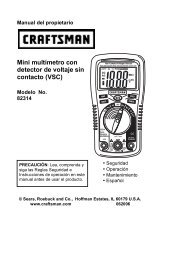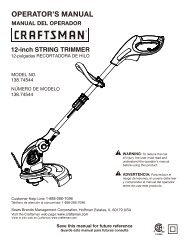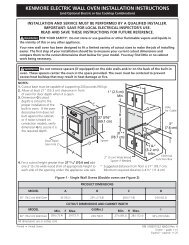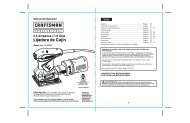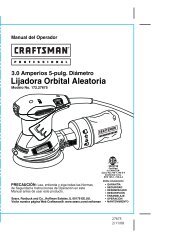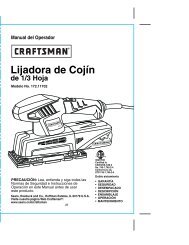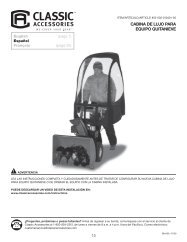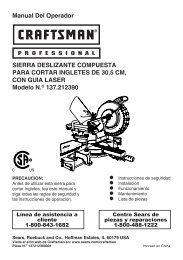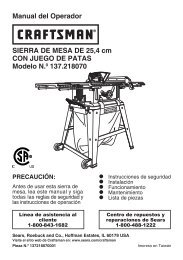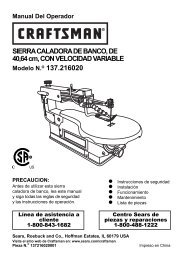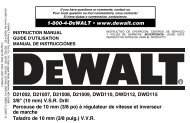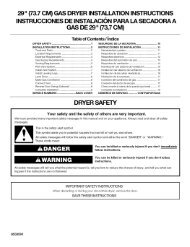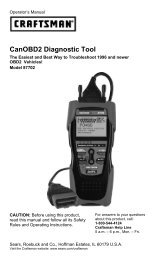Create successful ePaper yourself
Turn your PDF publications into a flip-book with our unique Google optimized e-Paper software.
OBD2 Systems<br />
I/M READINESS TESTING<br />
1. Using retrieved Diagnostic Trouble Codes (DTCs) and code<br />
definitions as a guide, and following manufacturer's repair<br />
procedures, repair the fault or faults as instructed.<br />
2. After the fault or faults have been repaired, connect the<br />
CanOBD2&1 <strong>Scan</strong> <strong>Tool</strong> to the vehicle's DLC and erase the code or<br />
codes from the vehicle's computer memory.<br />
� See page 36 for procedures for ERASING DIAGNOSTIC<br />
TROUBLE CODES (DTCs) from the vehicle's on-board<br />
computer.<br />
� Write the codes down on a piece of paper for reference before<br />
erasing.<br />
3. After the erase procedure is performed, most of the Monitor icons on<br />
the CanOBD2&1 <strong>Scan</strong> <strong>Tool</strong>’s display will be flashing. Leave the<br />
CanOBD2&1 <strong>Scan</strong> <strong>Tool</strong> connected to the vehicle, and perform a<br />
Trip Drive Cycle for each "flashing" Monitor:<br />
Misfire, Fuel and Comprehensive Component Monitors run<br />
continuously and their icons will always be on solid, even after<br />
the erase function is performed.<br />
� Each DTC is associated with a specific Monitor. Consult the<br />
vehicle's service manual to identify the Monitor (or Monitors)<br />
associated with the faults that were repaired. Follow the<br />
manufacturer's procedures to perform a Trip Drive Cycle for the<br />
appropriate Monitors.<br />
� While observing the Monitor icons on the CanOBD2&1 <strong>Scan</strong><br />
<strong>Tool</strong>’s display, perform a Trip Drive Cycle for the appropriate<br />
Monitor or Monitors.<br />
WARNING: If the vehicle needs to be driven in order to perform a<br />
Trip Drive Cycle, ALWAYS have a second person help you. One<br />
person should drive the vehicle while the other person observes the<br />
Monitor icons on the CanOBD2&1 <strong>Scan</strong> <strong>Tool</strong> for Monitor RUN status.<br />
Trying to drive and observe the CanOBD2&1 <strong>Scan</strong> <strong>Tool</strong> at the same<br />
time is dangerous, and could cause a serious traffic accident.<br />
4. When a Monitor's Trip Drive Cycle is performed properly, the<br />
Monitor icon on the CanOBD2&1 <strong>Scan</strong> <strong>Tool</strong>’s display changes from<br />
"flashing" to "solid,” indicating that the Monitor has run and finished<br />
its diagnostic testing.<br />
� If, after the Monitor has run, the MIL on the vehicle's dash is not<br />
lit, and no stored or pending codes associated with that<br />
particular Monitor are present in the vehicle's computer, the<br />
repair was successful.<br />
� If, after the Monitor has run, the MIL on the vehicle's dash lights<br />
and/or a DTC associated with that Monitor is present in the<br />
vehicle's computer, the repair was unsuccessful. Refer to the<br />
vehicle's service manual and recheck repair procedures.<br />
The Enhanced CanOBD2&1 <strong>Scan</strong> <strong>Tool</strong> is a special diagnostic tool that<br />
communicates with the vehicle's computer. The CanOBD2&1 <strong>Scan</strong> <strong>Tool</strong><br />
lets you view and/or "capture" (record) "real-time" Live Data. This<br />
information includes values (volts, rpm, temperature, speed etc.) and<br />
CanOBD2&1 45




